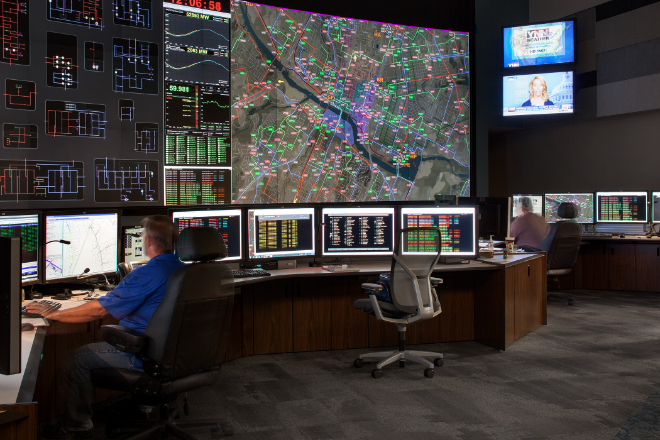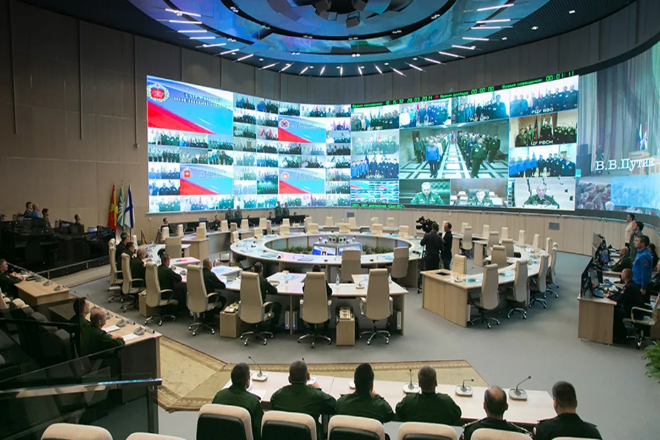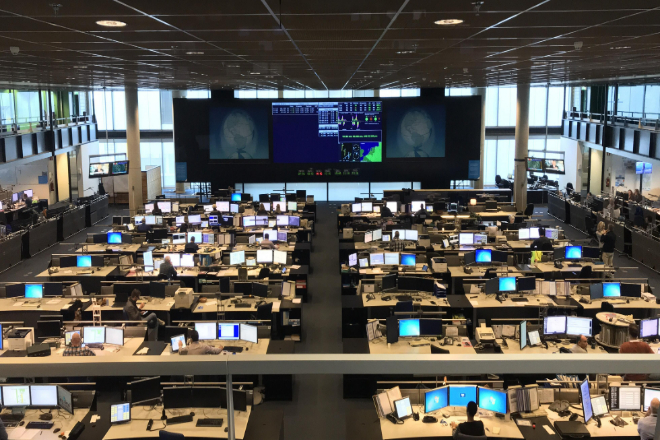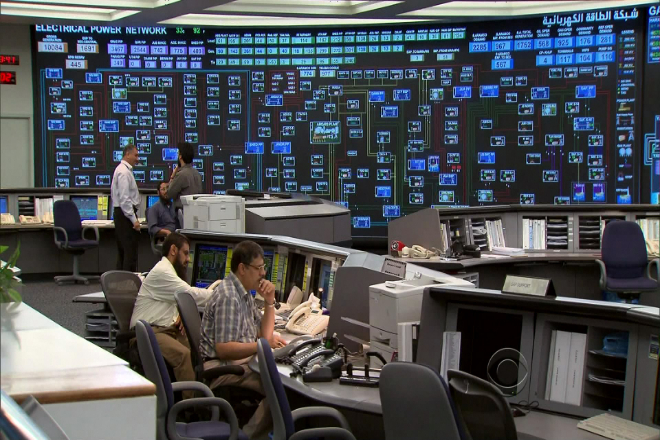Introduction

In the rapidly developing urbanization process, the city monitoring center, as the “brain” of the smart city, bears the heavy responsibility of maintaining public safety, optimizing urban management, and promoting social development.
How to select high-quality products that meet current needs and are forward-looking has become a very important issue. So what “qualities” should the LED display installed in the city monitoring center have?
1. Ultra-high-definition visual excellence

When discussing the ultra-high-definition visual excellence of the LED display of the monitoring system, we can deeply understand their importance in improving the visual experience, ensuring the accuracy of monitoring recognition, and emergency response efficiency from three aspects: high-definition display, color accuracy, and brightness and contrast.
1). High-definition display:
High-definition display technology allows the details in the image to be displayed more clearly by providing higher resolution.
This is crucial in the LED display display monitoring scene. High resolution means that the camera can capture more detailed information, whether it is tiny object movements, facial features, or subtle changes in the environmental background.
These details are crucial for security monitoring because they may be key clues to identify abnormal behavior, prevent crime, or respond to emergencies in a timely manner.
For example, in crowded places, high-definition cameras can quickly lock and identify individuals with abnormal behavior, providing security personnel with instant alerts and accurate location information.
2). Color accuracy:
Color accuracy is an integral part of the LED display screen of the monitoring system. It ensures that the color of the image captured by the camera is as consistent as possible with the color in the real world.
In the monitoring and identification process, the accuracy of color information is crucial for distinguishing different objects and identifying specific color markers or alarm signals. For example, in traffic monitoring, accurate identification of the color of the vehicle can help track the escape vehicle.
In the medical environment, color accuracy is equally important for identifying the changes in the patient’s skin color and judging the progression of the disease. In addition, color accuracy can also improve the overall reliability of the monitoring system and reduce false alarms or missed alarms caused by color distortion.
3). Brightness and contrast:
Maintaining the clear readability of the monitoring image displayed on the LED display screen under different lighting environments is a technical challenge. The adjustment of brightness and contrast is crucial to meet this challenge.
Brightness determines the overall brightness of the LED display screen image, while contrast affects the degree of difference between the light and dark parts of the image. In strong light environments, appropriately reducing brightness and increasing contrast can avoid overexposure of images and ensure that details are clearly visible.
In weak light environments, increasing brightness and adjusting contrast can enhance image visibility and reduce noise interference. This dynamic adjustment capability is essential to ensure that the monitoring system can provide high-quality image output in all weather and all scenarios.
Especially in emergency response situations, clear and readable images can quickly convey key information and provide strong support for decision-makers.
2. Super strong stability and reliability
When discussing the super strong stability and reliability of the LED display screen of the monitoring system, we can deeply understand how they work together to ensure the continuous and efficient operation of the monitoring system and the ability to cope with various complex environments from three key aspects: Stable operation, fault warning, and environmental adaptability.
1). Stable operation:
Stable operation is one of the core requirements for the LED display screen of the monitoring system. This means that the LED display screen must be able to continuously provide high-quality monitoring services around the clock and all year round.
To achieve this goal, the LED display screen of the monitoring system needs to adopt highly reliable hardware devices and software architecture to ensure that there will be no performance degradation or failure during long-term operation.
In addition, the system also needs mechanisms such as automatic restart, data backup, and recovery to deal with possible unexpected situations and ensure the continuity and integrity of the LED display monitoring service.
This 24-hour uninterrupted and stable operation capability, 7 days a week, is an important guarantee for the monitoring system to detect and respond to various security incidents in a timely manner.
2). Fault warning:
The fault warning system is another important pillar of the stability and reliability of the LED display of the monitoring system.
By integrating intelligent monitoring and warning technology, the system can monitor the operating status of the LED display of the monitoring system in real-time and promptly detect and report potential faults or performance problems.
This warning information can help maintenance personnel take measures in advance to solve potential problems and avoid the occurrence or expansion of faults.
For example, when the system detects that the image quality of a camera has deteriorated, it can automatically send a warning message to prompt maintenance personnel to check and repair. This intelligent fault warning mechanism not only improves the maintenance efficiency of the system but also greatly reduces the risk of service interruption caused by faults.
3. Possess intelligent integration

1). System integration:
Your LED display is not just a display device; it has also become a very good partner with the monitoring system, and they work closely together. What does this mean? That is, when you are watching the LED screen, you don’t need to switch interfaces back and forth.
All important monitoring information – real-time images, alarm prompts, and data analysis, are all clear at a glance. What’s more amazing is that the two can work together to make some “automatic response.” For example, once the monitoring finds something wrong, such as someone breaking into a place they shouldn’t enter, the screen will immediately highlight it and send you an emergency notification, allowing you to react in seconds.
This deep integration is like installing an accelerator on the monitoring system, which speeds up our security work.
2). Remote control:
The remote control function of the LED display is like adding wings to the monitoring system. You no longer need to go to the monitoring room in person. As long as there is a network, your mobile phone and computer can become your “remote control.”
Which camera do you want to check? Just move your fingers. Is there a little problem with the system? Remote diagnosis and repair are easily solved.
This not only saves the trouble of running around but also greatly improves work efficiency. Imagine that you are drinking coffee at home and suddenly receive an alarm. You can immediately check the situation on the scene through your mobile phone.
3). Smart adjustment:
The smart adjustment feature is like installing a “smart brain” on the LED display screen of the monitoring system. It will automatically adjust the brightness of the display screen according to changes in the environment.
When the sun is strong during the day, it will adjust the brightness to ensure that you can see clearly; at night or on cloudy days, it will adjust the brightness to protect your eyes and save electricity. There is also an intelligent energy-saving mode, and the system will automatically adjust the working status according to the usage.
For example, if there are few people in the middle of the night, it will automatically reduce the video quality of the camera, or some cameras can simply be put into sleep mode and wake them up when needed. This not only saves energy but also extends the service life of the equipment, which is simply killing two birds with one stone.
4. Flexible scalability to adapt to any needs
1). Modular design:
To put it bluntly, modular design is to disassemble the LED display screen of the monitoring system into “building blocks”; each building block has its own specific function. There are many advantages to this design! For example, if you want to add a few monitoring points, that’s no problem.
Just add a few camera modules without having to rebuild the entire system. For another example, if there is a problem with a module, just replace it, and it will not affect the work of other parts.
This design makes the LED display screen of the monitoring system very flexible. You can expand it and upgrade it as you want. Just like building blocks, you can build the most suitable monitoring system according to your needs.
2). Interface diversity:
Interface diversity is another magic weapon for the flexible scalability of the LED display screen of the monitoring system. Think about it: there are a variety of monitoring devices on the market now, including analog, digital, network, and various strange interfaces.
If a monitoring system can only support one or several interfaces, how inconvenient it would be! Therefore, a good LED display screen of a monitoring system must support a variety of signal input and output interfaces. In this way, no matter what kind of device you are, you can easily access the system and achieve seamless docking.
In this way, whether it is old equipment or new equipment, it can find a place in the system, making monitoring work smoother.
3). Software upgrade:
Software upgrade is the “internal skill” of the flexible scalability of the LED display screen of the monitoring system. We all know that technology is constantly improving, and new functions and algorithms are emerging in an endless stream.
If the software of the LED display screen of a monitoring system cannot be upgraded, it will soon be eliminated. Therefore, a good monitoring system must have software upgradeability. In this way, when new technologies or algorithms emerge, the system can “evolve” through software upgrades to keep up with the times.
For example, artificial intelligence is very popular now. If the system can support artificial intelligence algorithms, the accuracy and efficiency of monitoring can be greatly improved. And this “evolution” ability is achieved through software upgrades.
5. With economic rationality, cost-effectiveness can be maximized

1). Initial investment analysis:
First, let’s talk about buying a display screen. There are many kinds of LED displays on the market, and the prices vary greatly. Generally speaking, high-quality things are naturally expensive, such as those using the latest Micro/Mini LED technology.
The display effect is awesome, but the price is also relatively high. However, you have to think that although the initial investment is more expensive, high-quality displays are more worry-free to use and have a longer lifespan, which may be more cost-effective in the long run.
Of course, you can’t blindly pursue high-end. You have to base it on your actual needs. For example, if it is used for monitoring, then you have to pay attention to the display effect and clarity so that you can capture every detail more accurately.
If it is used for advertising display, you have to consider the color reproduction and viewing angle to make the advertising effect even better. Therefore, when comparing the cost differences of different quality displays, we have to consider multiple aspects and find the one that suits us best.
2). Long-term operating costs:
After talking about the initial investment, let’s talk about long-term operating costs. This includes a lot of expenses such as energy consumption, maintenance, and upgrades, but they are all real money!
In terms of energy consumption, although LED displays are already quite energy-saving, the electricity bill is also a considerable expense after long-term operation. Therefore, when choosing a display, you need to pay attention to its energy efficiency level and power consumption and try to choose those with low power consumption.
Maintenance costs should not be ignored. Although high-quality displays are more reliable, they are inevitably a headache. However, the good news is that they often adopt modular design, which is particularly convenient to maintain.
If there is a problem with any part, just replace it directly without having to replace the entire thing with a major construction. In this way, the maintenance cost is greatly reduced.
The upgrade cost must also be taken into account. Technology is changing with each passing day, and the display screen must keep up with the times. High-quality display screens usually have better upgrade scalability and can easily cope with future technology upgrade needs. In this way, we don’t have to change the screen frequently, saving a lot of money.
3). Return on investment:
Finally, we have to talk about the return on investment. To put it bluntly, whether the display screen you spent so much money on can bring you enough returns.
High-quality LED display screens have a lot of advantages in this regard. They can present the monitoring screen or advertising content more accurately and improve our work efficiency or advertising effectiveness.
In this way, our income will naturally increase. Moreover, high-quality display screens have a low failure rate and a long life, which reduces downtime and maintenance costs. The time and money saved are actually what we earn.
So, when choosing an LED display screen, you have to take a long-term perspective and comprehensively consider multiple aspects such as initial investment, long-term operating costs, and return on investment. Although the initial investment in high-quality display screens may be higher, they can bring more benefits and peace of mind in the long run. In this way, your wallet can be bulging!
Conclusion
In summary, the application of high-quality LED display screens in urban monitoring centers is not only a reflection of technological progress but also a concrete practice of the concept of smart city construction.
By choosing LED display screens with high-definition visual experience, stable and reliable operation, intelligent integrated management, flexible expansion capabilities, green security guarantees, and economic rationality, we can not only significantly improve the work efficiency and emergency response speed of the monitoring center, but also lay a solid foundation for the sustainable development of the city.
Finally, if you want to know more about LED display screens, please get in touch with us.
